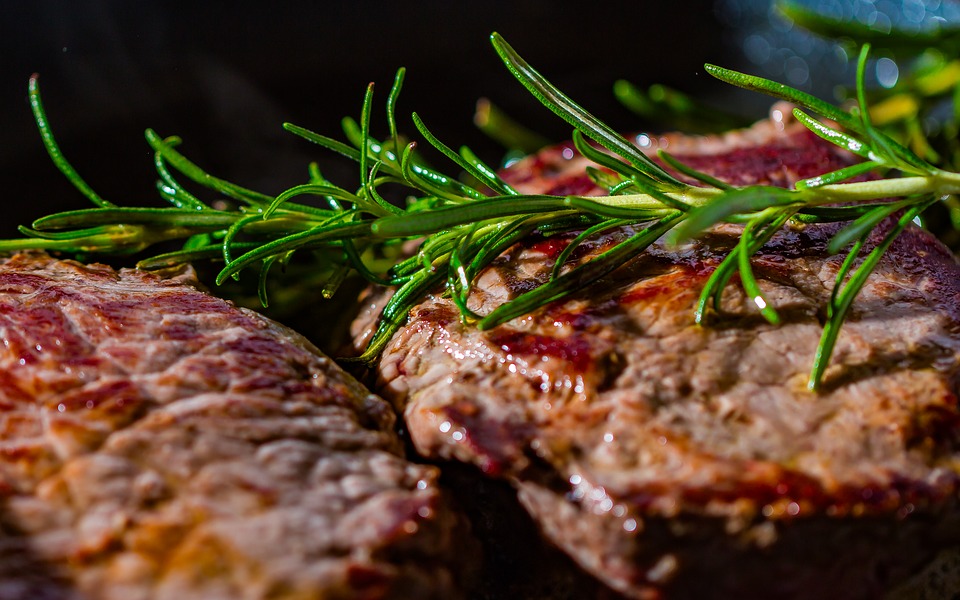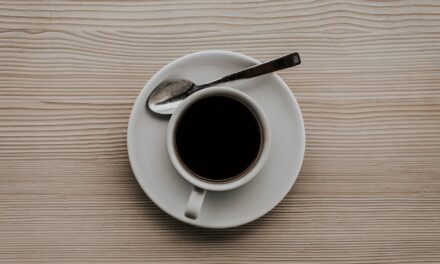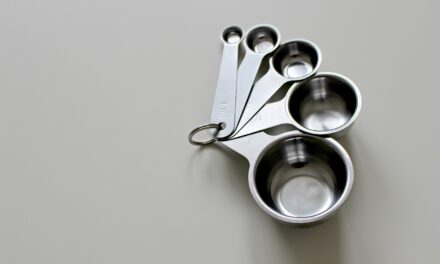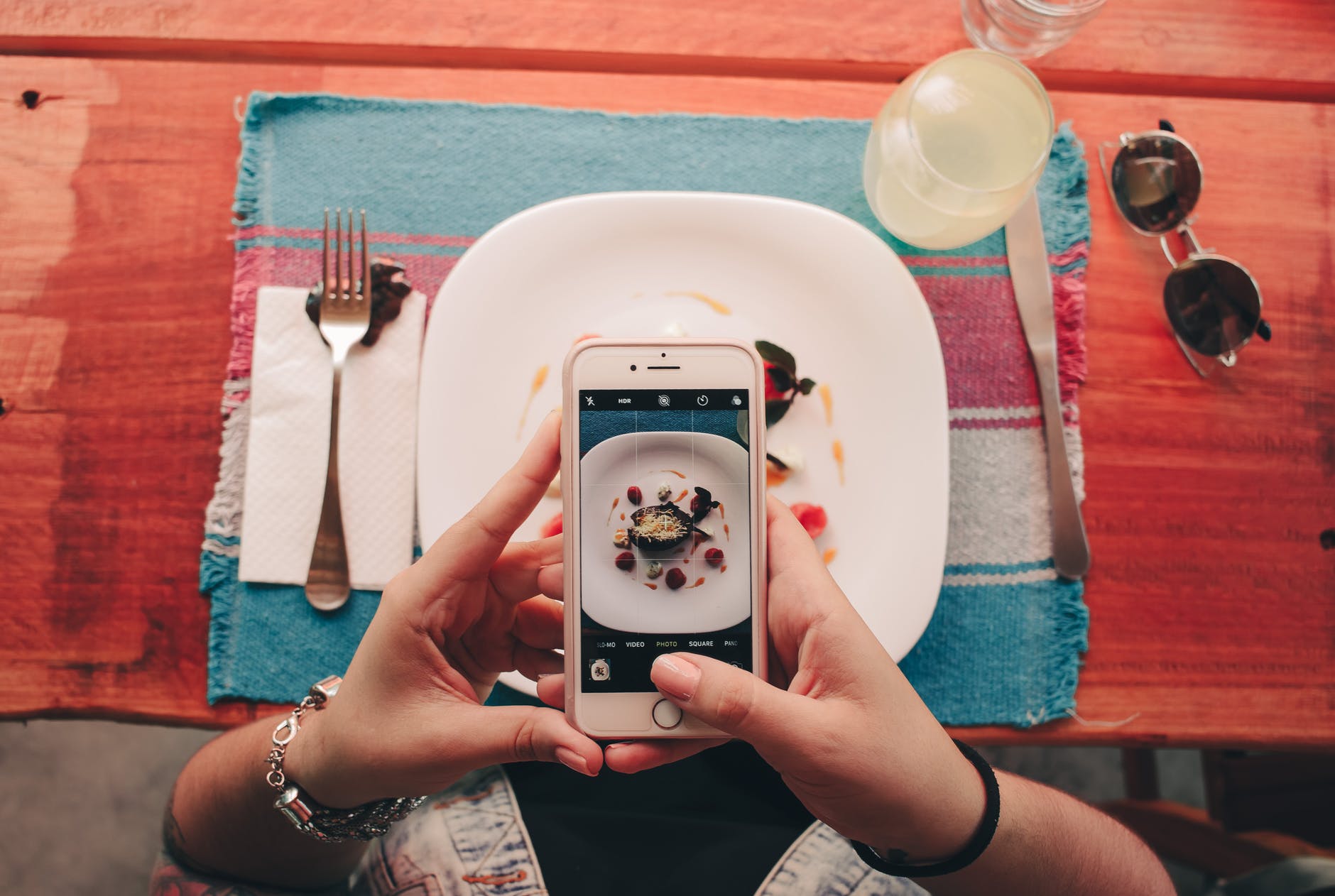Most people who write articles on this subject don’t tell you the whole truth about it.
They’re happy to share the advantages of not counting (like not having to deal with as many numbers), but they never share the downfalls of the approach. And trust me: there are downfalls.
Whether you lose weight comes down to whether you’re burning more calories than you take in (a “deficit”). Think of this like spending less than you make when you want to get out of debt.
Obviously, it’s hard to get out of debt if you don’t know how much you’re spending. You can take educated guesses, but you’re still leaving success to chance. Trying to lose weight without counting calories is no different.
It’s also harder to bust through “plateaus.”
If you’re counting calories and not seeing progress, you know exactly what to adjust. After all, you have hard “data” in front of you.
When you don’t have this data, however, it’s hard to tweak your plan. In most cases, all you can really do is eat smaller portions and hope for the best.
Unfortunately, this may result in accidental undereating, because you won’t be 100% sure of how much less to eat — which is why I’m generally partial to being in touch with the numbers. There’s no guesswork, and you can easily make adjustments if your progress stalls.
I know, I know.
You’re not here to get talked into counting calories. I understand this, and I am going to show you how to lose weight without it. But I wouldn’t be doing my job if I didn’t you the whole truth, so you know what to expect when you try it. Fair enough?
In my experience, four types of clients do best with this approach:
- People with extensive tracking experience who are sick and tired of MyFitnessPal
- People who got “obsessive” with tracking and need a numerical breather
- Insanely busy parents and professionals who aren’t willing to prioritize tracking
- People who are in no rush to lose weight
In each of these scenarios, these clients are aware of the cons of not counting, and decide the pros outweigh them. If this describes you, too, here are the eight most effective ways to lose weight WITHOUT counting calories:
1) Don’t let yourself get too hungry
When a slingshot gets pulled back, it doesn’t stop at its baseline. It rockets forward, as far as it can go. The same thing happens when you get really hungry. You rocket past your “baseline,” and eat until you’re Thanksgiving-stuffed. I call this phenomenon the Hunger Slingshot.
Needless to say, this level of overeating results in extremely high calorie days. If you want to avoid this (and hindering your progress), you need to keep your hunger in check. Here’s how:
- Put your sleep on a pedestal. Bad sleep habits lead to more next-day hunger and less weight loss over time
- Have more protein and fruits and vegetables. These are the most filling foods you can have on your plate (more on this shortly)
- Eat evenly portioned meals throughout the day. Scientifically speaking, this isn’t necessary for weight loss (total calories are king). But a decade of working with actual human beings has shown me how important this still is
If you use these strategies, you won’t experience the Hunger Slingshot as often.
2) Eat without distractions
I realize this isn’t always possible, especially if you’re always on the go. But if you regularly eat at your desk, in front of a TV, or while scrolling your phone, this NEEDS to change — or accidental overeating is inevitable.
When you address this, and actually notice when you’re full, you won’t finish every meal. I’m sure your mother told you not to do this growing up, but it’s actually a good idea. It’s a sign you’re paying attention to what your body needs, and now you have leftovers.
If this is something you struggle with, be sure to request a free copy of my Mindful Eating Checklist:
Within minutes, you’ll be making better food decisions.
3) Structure your plate well
Unless you’re splurging, a protein and a fruit or vegetable should be on almost every plate. Protein is very filling, helps you build muscle, and is incredibly hard to store as body fat. Fruits and vegetables are high in fiber and micronutrients, which keep you full and feeling your best.
Here’s a helpful visual — with steak, asparagus, potatoes, and olive oil as an example:
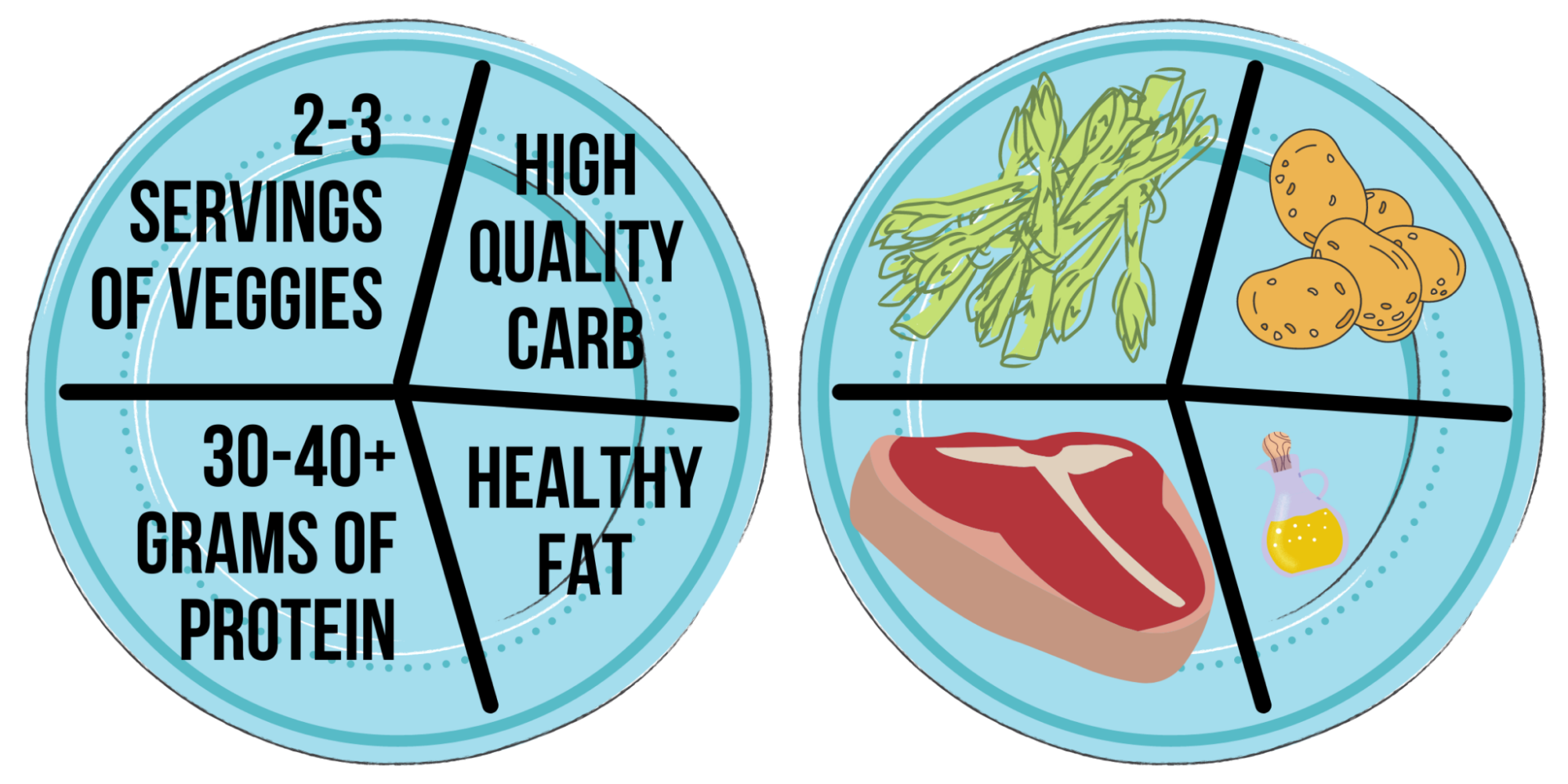
If getting enough protein is another struggle of yours, the Protein Power-Up is your answer. It’s my most in-depth, comprehensive guide on keeping hunger at bay and looking your leanest. You can request a free copy right here.
4) Minimize liquid calories
Liquid calories add up ridiculously fast. In fact, no matter how “perfectly” you eat, liquid calories will single-handedly hold you back if you don’t pay attention to them. This might mean your morning coffee, lunchtime soda, or near-nightly glass of wine needs to go.
Nobody wants to hear this (especially when it comes to alcohol), but the alternative is taking actual food off your plate — which is a horrible idea on so many levels.
5) Keep an eye on oils, sauces, and dressing
Ever see an Italian use a “drizzle” of olive oil? It’s half a day’s worth of calories.
I say this semi-sarcastically, as most people — Italian or not — are wildly out of touch with “actual” portions of oils, sauces, and dressings. As a result, they have 1,000-2,000+ “sneaky” calories per week, and completely stunt their progress. Here’s how to avoid this:
- When you’re cooking with oil: Pour a small amount directly into a serving bowl. Then, put whatever you’re cooking in the bowl, and mix it around. You won’t need nearly as much to get the same flavor
- Invest in an air fryer. I use mine 5-6+ times per week, and use very little oil (without sacrificing flavor)
- Use the “Fork Method.” Instead of pouring dressing directly onto your salad, you put it onto a side dish and dip your fork in it before grabbing a bite. This gives you all the flavor without all the calories
- Use more seasonings: like roasted garlic and herbs, paprika, and sea salt. Your food will be tastier, and you won’t need as many sauces to give your meals flavor
Nobody’s saying you have to eat bland food — just to be a little more creative.
6) Keep snacking to a minimum
At least once per day, I’m asked about the “best snacks for weight loss.” My answer tends to disappoint people:
If you’re always hungry for a snack, that’s a red flag. Your sleep, protein, or vegetable intake probably needs to improve, among other things. Frequently snacking is nothing more than a Band-Aid for these issues.
That said, if you find yourself in a situation that lends itself to snacking (ex. a lengthy road trip or work conference), here are the snacks I recommend the most:
- Greek yogurt
- Cottage cheese with fruit
- Tuna packs
- Premade protein shakes
- Fruit (any kind)
- Snackable vegetables (ex. baby carrots)
- Beef jerky
- Cheese sticks
- Nuts (in moderation)
Notice I don’t have any protein bars on this list. In most cases, they’re hard on people’s stomachs, not very satisfying, and about as nutritious as candy bars.
7) Avoid splurging twice in a row
This won’t be easy to do if your diet is restrictive, as underlying deprivation often causes people to spiral. That said, it’s generally wise to avoid splurging several times in a row. As few as 2-3 “blow-outs” can erase a weeklong deficit — especially if you’re a woman.*
What does this actually look like?
- Choosing to have a protein-packed wrap for lunch after having pancakes for breakfast
- Choosing to have a fruit smoothie for breakfast after having pizza the night before
- Choosing to have a water with dinner after having a cocktail with lunch
You won’t be perfect with this, and splurges aren’t inherently “off track.” But if you want to consistently lose weight, you need to eat mostly nutritious foods.
*Women tend to have lower “maintenance calories” than men, meaning it takes fewer calories to maintain their bodyweight, and even fewer to produce weight loss.
8) Increase your TDEE
Each of the first seven strategies in this article will help you eat fewer calories. But it’s equally important to know how to burn more calories. This is where your TDEE becomes relevant.
Your TDEE is your “total daily energy expenditure”: how many calories you burn on a daily basis. If you increase this, you won’t need to eat so little to lose weight.
Here’s what makes up your TDEE:
- Your BMR (basal metabolic rate). This is how many calories your body needs to perform basic life functions (like circulating blood) and accounts for 60-75% of your TDEE
- NEAT (non-exercise activity). This includes everything from your steps to how much you fidget at your desk (10-15% of your TDEE)
- Your workouts. These only make up 5-15% of your TDEE
- The thermic effect of food. This refers to the calories burned during digestion (~10% of your TDEE)
Surprisingly, exercising more — especially if you’re already strength training 3-4 days per week — isn’t a major TDEE booster. It’s only 5-15% of the equation, your body adapts to it quickly, and it can spike your hunger levels. Here’s what I recommend focusing on instead:
- Taking your sleep very seriously
- Managing your stress (unsexy but underrated)
- Getting stronger and developing muscle
- Getting 6,000-8,000+ steps per day
- Eating ~.8 grams of protein per pound of bodyweight
These five strategies alone will spike your TDEE — and none of them require you to live in the gym.
Now what?
It’s crucial for you to know exactly how to assess your progress. If you don’t, you won’t know whether your approach is working — which leads to needless frustration.
Here’s what to look for:
- Bodyweight average trends. If a client is losing ~5-1% of their bodyweight most weeks, we change nothing. Notice I said “most,” not “every.” Scale change isn’t linear, no matter how perfectly you think you eat
- Changes in measurements. If a client isn’t seeing change on the scale, but their measurements are moving, we change nothing. The scale is a good tool in the toolbox, but it doesn’t tell us everything we need to know
- Changes in progress photos. Ultimately, the only reason we want lower weigh-ins and measurements is because we want our photos to look different — which is why we change nothing if there’s visible change here (Noticing a trend?)
These are the big three, but it’s equally important to pay attention to how your clothes fit, how your body is feeling, and whether your relationship with food is improving.
What if I’m NOT seeing progress?
This is where things get tricky, as you won’t know where the “extra” calories are coming from. But I can tell you this with complete certainty: The WORST thing you can do in this situation is eat significantly smaller portions. The goal of any sensible diet is keeping as much food on your plate as possible (while still losing weight).
Which I why I follow these steps instead (in this specific order):
- First, we address the obvious culprits — like mindless grazing, desserts, and alcohol
- After 2-3 weeks, if there’s still no visible progress, we add MORE of the following: sleep, stress management strategies, daily steps, protein, or vegetables
- After another 2-3 weeks, if there’s still no progress (this is rare), we consider having fewer carbs
This does NOT mean carbs are “bad,” “unhealthy,” or “fattening.”
In fact, they’re a dieter’s best friend, and improve everything from workouts, to metabolic health, and even brain function. Not to mention, they’re delicious, and support sustainable success. I could write a damn novel on how much you need them (even if your goal is weight loss).
But if we have to take some food off your plate (to reduce total calories), this is generally safer than reducing protein or fats.
A final thought:
Counting your calories is reliable, effective, and allows for food flexibility. Losing weight without counting calories is “freeing,” equally flexible, and supports lifelong success.
In other words: BOTH strategies work.
Sadly, people pit them against each other, as if calorie counting is obsessive (it’s the opposite if you do it well), and not counting is lazy (it’s not). The reality is, you need to weigh the pros and cons of each, and decide which approach is best for YOUR personal journey. Don’t let anybody else tell you otherwise.
Including social media influencers.
It drives me bananas to see them say, “Calorie counting isn’t necessary! Listen to your body instead.” Unfortunately, our inability to do this well is what got us into a jam in the first place.
Not to mention, 95% of these influencers have vast food tracking experience. In most cases, they spent 2-3+ years meticulously tracking and measuring every last morsel of food they put into their mouth. This is what allows them to now “listen to their body” and make pretty good decisions.
(They conveniently leave this out of their sales pitches.)
I’m not saying you have to count your calories. You don’t “have” to do anything. But I also won’t shy away from telling you that even 30-60 days of tracking will dramatically increase your chances of success when you’re not tracking.
Ready for a recap?
I know I threw a lot at you, and I want to make sure you know exactly what to do next:
- Don’t let yourself get too hungry
- Eat without distractions
- Structure your plate well
- Minimize liquid calories
- Keep dressings, oils, and sauces to a minimum
- Minimize snacking
- Avoid splurging twice in a row
- Increase your TDEE
While you’re at it, avoid influencers whose only advice is to “listen to your body.” You deserve better, and these eight strategies are a great start.
What are your thoughts? What questions do you have on losing weight without counting calories? Let me know in the comments below.

